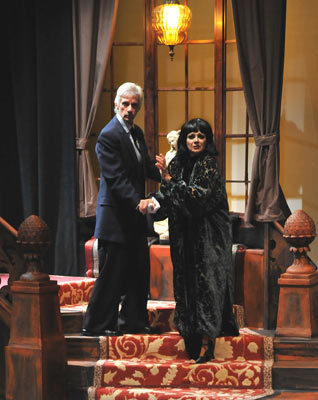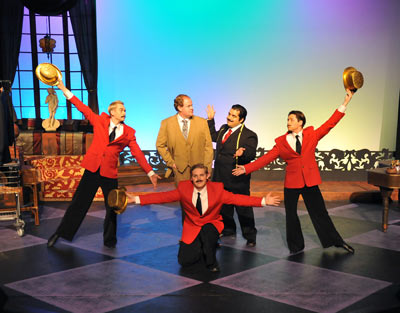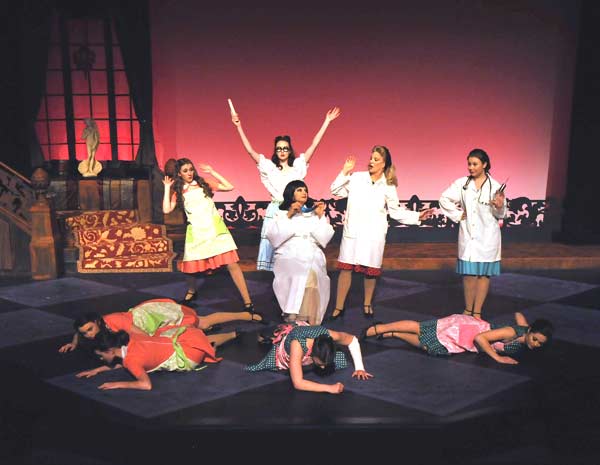The musical, Sunset Boulevard has a checkered history. Various productions of the musical have received very mixed reviews. When it’s been good, it’s very, very good, and when it’s not, it’s landed like a thud. The musical owes its roots to the 1950 film by Billy Wilder that tells the story of the relationship between an out-of-work screenwriter (Joe Gillis), desperate to procure some funds and a forgotten silent film star (Norma Desmond) who sees him resurrecting her career as well as her love life. Wilder’s film starred “long retired” silent screen star, Gloria Swanson and a very young William Holden, early in his career, and featured cameos by numerous Hollywood luminaries playing themselves (Cecil B. DeMille, Hedda Hopper, Buster Keaton , etc.), as well as an acting turn by silent film director Erich von Stroheim as the fading star’s butler + former husband + former director (Max), and the screen debut of young actress Nancy Olson as Gillis’s love interest (Betty Schaefer). The motion picture, now consistently ranked as one of the 20 best American films of all time (see http://bit.ly/1FURaJw and http://bit.ly/19cAFv5) won Mr. Wilder no friends in Hollywood, for its biting take on the way the motion picture industry treats its aging stars and behind-the-scenes talent. The movie was nominated for 11 Academy Awards, winning only three (screen play, set decoration & score) but none for acting, directing or best picture. Several attempts to adapt the film into a stage musical failed or were aborted, most notably by acclaimed Broadway theater composer Stephen Sondheim in 1980. Sondheim aborted his effort after consulting with Billy Wilder, who advised him that “You can’t write a musical about Sunset Boulevard, it has to be an opera. After all, it’s about a dethroned queen.”
The film was finally adapted into this musical stage play by Andrew Lloyd Webber in 1991. The musical was first performed at the 1991 Sydmonton Festival with Ria Jones in the lead role as faded silent screen star Norma Desmond, but it was not well received. It was revised and performed again at the 1992 Sydmonton Festival, with Patti Lupone in the lead role and was well enough received to move on as a West End production in London, again with Patti Lupone in the lead role. The musical premiered in America in Los Angeles in 1993, with Glenn Close in the leading role, and was an immediate success, running for 369 performances. It opened on Broadway in November 1994, again with Glenn Close in the leading role, winning her a 1995 Tony Award for Best Performance by a Leading Actress in a Musical. The musical was then taken on the road on a US national tour with Linda Balgord in the title role, but the tour was not successful and generated large financial losses. The musical set a record, which still stands, for the most money lost by a theatrical endeavor in the history of the United States. The losses were attributable to several factors – the poor reception of the play outside of Los Angeles and New York, costs of one of the most expensive sets in Broadway history as of that time, and legal settlements with dismissed actresses. The latter point really gets to the crux of the matter.
With the right actress in the lead role of the faded silent film star, the show is terrific. With a lesser actress in the role, the show suffers. In Wilder’s movie, actress Gloria Swanson was in fact a retired silent film star, who had never made the transition to talkies and whose career had faded. Swanson both knew how to act, beyond mere delivery of dialogue, and also what it was like to endure the fade of a prominent screen career. Original West End production lead actress, Patti Lupone thought she was going to Broadway with the show, but was replaced, after reviewers criticized her “Broadway belt” which drowned out the rest of the cast; she sued and eventually received a $1 million settlement, contributing to the theatrical show’s losses. Glenn Close, like Gloria Swanson in the lead role in the film version, was a skilled actress, with all the tools to deliver a nuanced performance of the faded film star lead role, and Close too had seen her screen career wane before this stage performance brought her renewed success, fame and fortune. Eventually Close was supposed to be replaced in the lead role in the show by actress Faye Dunaway, who went into rehearsals of the production. But shortly after rehearsals started, the producers announced that Dunaway was unable to perform the role to their standards and she was let go. She too sued and the producers eventually paid her a settlement as well.
Critics gave the original Broadway production mixed reviews – when leading actress, Glenn Close was on stage, giving “one of those legendary performances people will be talking about years from now” [THEATER REVIEW: SUNSET BOULEVARD; Boulevard Of Broken Dreams, David Richards, New York Times, November 18, 1994] “it is outlandishly good.” “Whenever Ms. Close is offstage, in fact, ‘Sunset Boulevard’ loses much . . . .” The producers tried to hold the audience’s attention with a “take-your-breath-away” set – including a majestic staircase, a forbidding pipe organ, a swimming pool viewed from the vantage point of the drain, and more. But the elaborate and extravagant set was not successful in compensating for “the mundane patches” when the lead character was off stage, nor in keeping the story interesting in her absence. Critic Richards described Ms. Close’s performance thusly: “Her voice is small and unexceptional. The amplification comes from her acting skills: the flashing eyes, the magnanimous stance, the histrionic gestures actually give the notes color and power.”
So with that checkered history, we come to Friday, March 20, 2015 when Camelot Theatre opened the newest production of Sunset Boulevard, with Livia Genise in the key role of Norma Desmond. To cut to the chase, the Camelot Theatre production of Sunset Boulevard is a fully realized categorical winner. Ms. Genise nails the crucial Norma Desmond lead role and Camelot Theatre has found successful ways to overcome the “mundane patches” when the attention-grabbing Norma Desmond character is off stage. Thus, the Camelot Theatre production retains the best elements of the original Broadway production, but it does it one better, and succeeds where the Broadway show failed.

Norma Desmond (Livia Genise) is escorted down the staircase of her Sunset Boulevard palace by her butler-former husband-former silent film director, Max (Mark Schneider). Photo: Steve Sutfin
Like the most successful actresses who preceded her in the Norma Desmond role, Livia Genise is fully equipped to deliver a nuanced performance of the faded film star, and well suited to the role. Ms. Genise is a veteran actress, who has been a member of Actors Equity Association since 1969 (that’s 46 years if you’re counting). She has performed from Broadway to Hollywood, guest starring on everything from Three’s Company to Hill St. Blues, including a four month stint on Days of Our Lives. She has won a number of acting awards in her career, including Best Actress in a Musical by the Bay Area Critics Circle for her portrayal of Rebecca in Rags, and Best Supporting Actress in a Musical as Hermione in Triumph of Love. Clearly she has the acting chops and knowhow to deliver a worthy performance of the complex Norma Desmond character. She, like Glenn Close and Gloria Swanson, also has the insight to understand, appreciate and convey the experience of aging as an actress, watching as opportunities to land ingénue roles fall away. I do not mean to imply that Ms. Genise is “over the hill” or “out to pasture”, like Norma Desmond. Ms. Genise has made the most of her maturity – after all she is the FOUNDER of the Camelot Theatre and has erected an extraordinary theater complex where there was once a barn in Talent, Oregon, filled it with a remarkable acting company, and continues to regularly venture back onto the stage in that company’s productions and other venues. Ms. Genise has aged like a fine wine, only getting better and honing her craft over time, but she still has a firm grasp on the career trajectory of an aging actress, and the ability to portray it to the nines. Like Glenn Close in the role on Broadway, Ms. Genise succeeds as Norma Desmond not with an exceptional singing voice, but by her acting skills: her posture, movement, facial glances, gestures, and subtleties of performance. One of the biggest songs in the show, “As If We Never Said Goodbye”, is offered when Norma returns to the studio where her career had long ago flourished. A bright spotlight is shined on the character, and using posture and movement and an arch of her neck, Ms. Genise succeeds in giving the audience Hollywood’s greatest actress and biggest box office star. Thus, like the best productions of Sunset Boulevard, the 2015 Camelot Theatre version succeeds because they have cast an apt gifted actress who fully inhabits the key role.
But the Camelot Theatre production succeeds even where the original Broadway show fell apart. To be sure, the Camelot Sunset Boulevard lacks the excessive, eye-popping set of the Broadway production: the grand staircase has been scaled down and the pipe organ is missing. Director Roy Raines, Artistic Director Livia Genise (yep, one and the same) and the crew of the Camelot production use other more successful techniques to keep the show interesting and the audience entertained even when the star is off stage. The choreography is superb throughout, sustaining much of the energy of the show and moving the story along nicely, when Ms. Desmond isn’t present. Camelot choreographer Sarah Gore deserves high praise for this effort. In the Wilder film, there is an automobile chase sequence where Joe Gibbs attempts to evade a pair of auto repo men, and ends up in Norma Desmond’s Sunset Boulevard palace’s garage. Camelot presents this on stage in a most effective and memorable way, using a wonderfully choreographed dance sequence, with Gibbs and the repo men weaving through cleverly costumed dancers and very creative props representing traffic and road symbols. Camelot’s staging, use of projected images (so the audience DOES get a swimming pool viewed from the vantage point of the drain), lighting (such as that spot on the star upon her return to the studio) and costuming are quite clever, creative and effective throughout.

Joe Gibbs (Nathan Monk – center left) is fitted with an expensive and lavish new wardrobe, paid for by Norma Desmond, by expensive tailor Manfred (Erny Rosales – center right), and salesmen (L to R: Joey Larimer, Zane Taylor & Reese Rush) in an elaborately choreographed song and dance number. Photo: Steve Sutfin
Not to be overlooked are the other characters in the story and the actors in those roles. Nathan Monks provides a terrific Joe Gibbs. He may not possess the kind of handsome good looks that a young William Holden does in the film version, but Mr. Monks delivers a more believable and better Joe Gibbs than Mr. Holden did. Mr. Monks’ singing was superb – he had the finest voice among the entire cast and used it well. But he can also act and held his own on stage against Ms. Genise’s Norma Desmond, which is so important to provide Ms. Genise a foil to play against, enabling her to elevate her performance.
The film version of Sunset Boulevard introduced a new young actress (Nancy Olson) in the role of Betty Schaefer. Camelot presents an unforgettable young actress in the role, Sarah Gore (yes, the choreographer). Ms. Gore is energetic, luminous and charismatic, and nearly steals the show, almost every time she steps on stage. She sings, dances, sashays, acts, and delivers the whole package in a performance that must be seen. She’s obviously on an upward trajectory and the sky’s the limit in her stage future. The significant role of Cecil B. DeMille, played by the real Cecil B. DeMille in the movie, is well played here by radio personality, political activist and author, Jeff Golden, who is a veteran of past Camelot Theatre productions, but has been absent from the stage for quite a while. He presents a very believable and effective performance here as Cecil B. DeMille and it’s nice to see him back on stage doing so. Mark Schneider renders a very credible Max Von Mayerling, Ms. Desmond’s very protective butler, former husband and former silent film director.
This being a musical, it should be noted that the music also was notably good. Of course, composer Andrew Lloyd Webber (Phantom of the Opera, Jesus Christ Superstar, Evita, Cats) knows how to pen a winning Broadway score. The Camelot Theatre production did a fine job of performing it. Not only was the music excellent in supporting the singers, but it also provided some of the energy and drive in moving the story along during what might otherwise have been the “mundane patches”. Kudos are well deserved all around for Music Director Michael Wing, Sound Engineer Brian O’Connor, and the six musicians working this show, with special recognition to drummer, Steve Sutfin, whose percussion contribution was exceptional and essential in keeping the energy level high throughout.
In its way, this Camelot Theatre Sunset Boulevard was better & more successful than the Broadway production. It may seem odd that a small theater company in backwoods Oregon far from the lights of Broadway could present a better version of the show than was offered to the New York City audience in a record breaking, extravagant money losing Broadway production – but that’s how life plays out sometimes. Camelot Theatre is fortunate to have had all the pieces in place and the chemistry to meld them together, to produce theater magic, which didn’t quite happen on Broadway. And in the end, Billy Wilder was wrong. You can write a Sunset Boulevard musical about a dethroned queen – as long as you can secure a regal actress to flesh out the queen role, as demonstrated by this season’s Camelot Theatre production of Sunset Boulevard with Livia Genise in the Norma Desmond role.
Performances of Sunset Boulevard continue at Camelot Theatre, 101 Talent Avenue, Talent through April 19, Thursday thru Saturday 8:00pm, Sunday Matinees 2:00 pm. For tickets: order online at http://bit.ly/1EO71aR, or call the box office at 541-535-5250, or in person at 101 Talent Avenue, Talent, Oregon.
Featured image caption: In a well choreographed song and dance number, forgotten silent screen queen Norma Desmond (Livia Genise) prepares for a comeback that never materializes with the help of a large coterie of attendees and assistants: clockwise from top (girl with arms up ) Lindee Newman, CJ Reid, Sutton Vie, Grace Peets (floor), Brianna Gowland, Keely McLean, Lauren Taylor, Shannon Carter. Photo: Steve Sutfin

 Lee Greene was born & raised in a NJ family where the only religion worshipped was classical music, Leonard Bernstein was God, and the radio was constantly on and tuned to classical station WQXR (which is now always on in his Jacksonville home thanks to the miracle of the Internet). Growing up in the New York City metropolitan area and later while residing and practicing law in NYC, Lee attended oodles of Broadway and off-Broadway theater productions, as well as concerts and opera at Lincoln Center, Carnegie Hall and other NYC venues. Lee is now a retired attorney, runs a computer support business, and has served on the boards of Rogue Opera & Siskiyou Violins. Lee also writes Performing Arts reviews published on the website,
Lee Greene was born & raised in a NJ family where the only religion worshipped was classical music, Leonard Bernstein was God, and the radio was constantly on and tuned to classical station WQXR (which is now always on in his Jacksonville home thanks to the miracle of the Internet). Growing up in the New York City metropolitan area and later while residing and practicing law in NYC, Lee attended oodles of Broadway and off-Broadway theater productions, as well as concerts and opera at Lincoln Center, Carnegie Hall and other NYC venues. Lee is now a retired attorney, runs a computer support business, and has served on the boards of Rogue Opera & Siskiyou Violins. Lee also writes Performing Arts reviews published on the website,
Here’s a video clip of Livia Genise’s extraordinary performance of the song, “As If We Never Said Goodbye” from the show. Wish I’d had that to embed with the review, as it illustrates precisely what I was describing in the review; watch the consummate acting, including posture, movement, facial glances, gestures, and subtleties of performance as she sings this number, presenting “Hollywood’s greatest actress”:
https://www.youtube.com/watch?feature=player_embedded&v=SmpXt5-ICfA